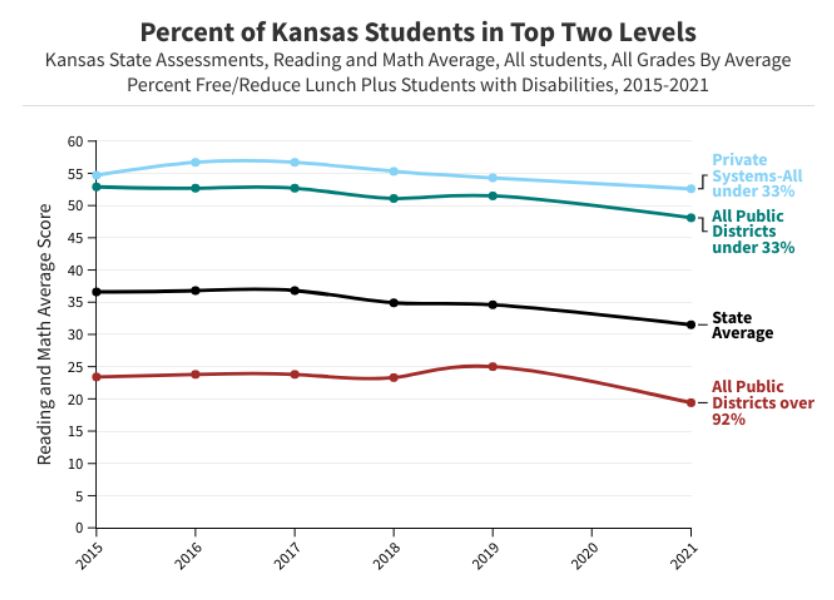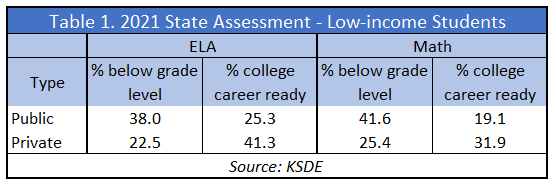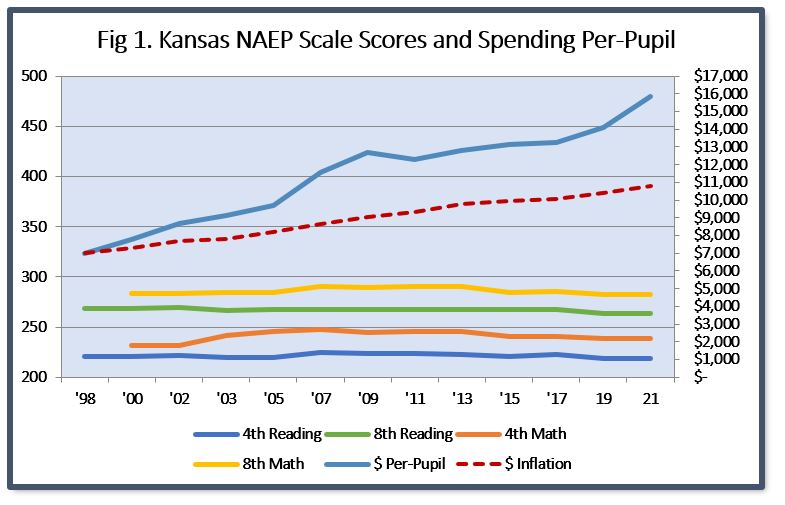An April 2022 report published by the Kansas Association of School Boards (KASB) entitled Understanding State Assessment Data, goes to great lengths to rationalize low and declining state assessment scores. The fifteen-page document can be divided into five categories of rationalizations that the unacceptably dismal state assessment scores are just fine:
- standards
- public vs. private schools
- low-income students
- funding
- post-secondary performance
You know right away where the report is headed because the it begins the with this strawman statement:
“Some legislators and critics of public schools say state assessments show student performance is alarmingly low, declining, and additional funding hasn’t helped. Other legislators and advocates for public schools say scores are low because Kansas has high standards, that performance was rising before budget cuts that schools haven’t fully recovered from and learning was set back by the COVID pandemic and that actual educational attainment is rising. Here are some facts about Kansas state assessments and student performance.”
Indeed, the report is full of facts and graphs, but many are irrelevant and lead to conclusions – either implicitly or explicitly – that are simply myths. Below, those myths are enumerated and debunked.
Myth #1 – Standards and performance are the same thing.
KASB statements:
“According to the U.S. Department of Education, Kansas proficiency standards for state assessments were the highest in the nation measured against the National Assessment of Educational Progress.”
“According to national research reports, Kansas has the nation’s highest benchmark scores on its state assessments compared to other states when compared against the NAEP, which indicates Kansas has set a very high goal for students to meet.”
Reality:
KASB would like you to believe that the standards are what really matter, not student performance. As long as standards are high, it doesn’t matter that performance is low. So, according to KASB, since NAEP performance is similar to state assessment performance, and Kansas standards are high according to NAEP, state assessment scores are right where they should be. Confused? So am I. Applying that logic to the world of sports, it’s OK for a team to have losing seasons perennially, as long as the standard each season is to win the championship.
Furthermore, local districts are not bound to teach to those standards, so, in effect, the argument touting high standards as a substitute for student performance is a spurious one.
Myth #2 – Public school state assessment scores are comparable to private school scores when looking at the big picture.
KASB statements:
“Private schools are not required to provide free education, special education or bilingual programs; and may establish higher standards for academics and behavior than public schools.”
“(State assessment) results in both public and private school groups have been declining.”
“Assessment results are strongly related to the needs of the student population, with private schools performing only slightly higher than similar public schools.”
Reality:
What KASB want you to believe is that private schools perform only slightly higher than public schools and that is a function of student demographics.
KASB goes to considerable length to make the case that any difference that exists is a function of public schools having to educate lower-income and special needs students. The graphic below that is presented in the report is how this conclusion is justified.
 What this graphic is attempting to display is that if you compare the “Private Systems,” as they refer to private schools, with public school districts with similar rates of low-income students there isn’t much difference between the two. What is missing in this graphic and subsequent discussion is that those public districts get millions in at-risk funding to help those low-income students while the private schools do not. (More on this in the next myth.)
What this graphic is attempting to display is that if you compare the “Private Systems,” as they refer to private schools, with public school districts with similar rates of low-income students there isn’t much difference between the two. What is missing in this graphic and subsequent discussion is that those public districts get millions in at-risk funding to help those low-income students while the private schools do not. (More on this in the next myth.)
Furthermore, KPI has shown that private schools do much better than public school districts in state assessments.


Myth #3 – State assessment scores for public schools would be higher if not for an increasing number of special needs students.
KASB statements:
“There are large differences in student performance based on factors like family income level, disability, and if the student is an English Language Learner. Schools can’t control these factors but try to address them with additional support.”
“(I)t is highly likely that more students would be achieving at higher levels statewide if the number of high need students was the same as 20 years ago.”
“Kansas school districts have more high need students than in the past, while pursuing higher academic standards.”
Reality:
What KASB conveniently leaves out of the discussion is that the districts get hundreds of millions of dollars each year to help the at-risk students, ELL, and/or special education students. This funding is almost entirely unavailable to private schools. As both KPI and Legislative Post Audit (LPA) have shown, at-risk dollars are not targeted toward those students. Achievement gaps persist for all special needs students, despite the incredible sums provided to increase performance. For example, at-risk funding has increased from roughly $50 million in 2005 to about $400 million in 2021 but achievement gaps have not improved.
Myth #4 – State assessment scores would be higher if funding hadn’t been cut.
KASB statements:
“Kansas test scores were rising when school funding was increasing more than inflation and began falling after per-pupil funding lost ground to inflation for nearly a decade.”
“(A)dvocates for public schools say scores are low because Kansas has (had) learning loss from eight years of underfunding.”
“From 1999 to 2009, Kansas’ total per-pupil revenue was rising more than inflation and moving closer to the national average and higher than the regional average. From the “Great Recession” in 2009 to 2014, Kansas and most other states declined in per-pupil funding when compared to inflation. Since then, Kansas funding has recovered more slowly than the rest of the nation and continued to fall behind inflation until 2017. In 2019, Kansas was still below 2009 inflation-adjusted levels and had fallen farther below the U.S. average than any year since 1999. Kansas was at about the same level of per-pupil funding as other states in the region.”
Reality:
‘It’s the Great Recession’s fault,’ ‘we’re below the national average,’ ‘eight years of underfunding’ – this is a bunch of gobbledygook and KASB should know better. But, hey, when in doubt, blame low scores on never sufficient funding, right?
The fact is per-pupil spending is now north of $16 thousand per year. Figure 1 shows that while funding has far outpaced inflation since the late ’90s, NAEP assessment scores are essentially flat before, during, and after the Great Recession. 
Plus, there is this subtle implication: if funding decreases, test scores will instantly go down, but when funding goes up it takes years to recover from a lack-of-funding-induced reduction in achievement. The data in Figure 1 shows there is no foundation for that implication. This form of rationalizing poor school performance is getting old.
Myth #5 – State assessment scores are comparable to the increasing amount of post-secondary achievement.
KASB statements:
“In 1990, less than 50 percent of the Kansas population over age 24 had any college participation and only 21 percent had a four-year degree or higher. In 2020, two-thirds of Kansas have some college participation, and 34 percent have earned a four-year degree or higher – approximately that percentage of students scoring at Levels 3 and 4 on state tests.”
“(W)hile scoring at Levels 3 and 4 is a strong indicator that a student is well prepared for postsecondary education, many who score at lower levels are also able to be successful.”
“From 2009 to 2021, the number of Kansas high school graduates has increased from 32,000 to almost 35,500 or about 10 percent. The number of credentials awarded by Kansas postsecondary institutions, including technical certificates, two- and four-degree and advanced degrees to students up to age 24 has increased from 20,000 to 27,000 or about 35 percent.”
Reality:
Now here’s a real headscratcher. KASB is conflating college degree percentages with state assessment scores. They state that in 2020 34% of Kansans have a college degree, which is comparable to the percentage of students who test “college/career ready” on state assessments. Comparing those two outcomes is like comparing cotton to cotton candy. What does the percentage of Kansans who have earned college degrees have to do with test scores of kids as young as eight in the present day?
Also, what they leave out is the rate at which college students must take remedial courses in order to be prepared for real college courses. A 2022 audit by Legislative Post Audit found that roughly one-third of Kansas graduates took a remedial (developmental) course at a post-secondary institution in 2020. The audit included a survey of post-secondary instructors. Eighty-seven percent of the respondents claimed that inadequate high school coursework is a factor necessitating remedial college coursework. Eighty-three percent claimed that high school graduation requirements are a factor in the need for remedial coursework. Perhaps if state assessment scores went up, especially those in the latest year students take the assessments – 10th grade – the need for college remediation would go down.
Conclusion
One could summarize KASB’s faulty justification for poor and declining state assessment scores in a single (yet lengthy) sentence. Public school state assessment scores are right where they should be because the state has the highest standards in the nation; public schools have such a high incidence of low-income, harder to educate students and private schools do no better when controlling for income level; the scores are a virtual mirror image of post-secondary performance; and the scores reflect the underfunding districts must endure. That’s an excuse they would like the world to believe.
But the time for excuses is long past over. The time now is for action. The real reason state assessments are so low has nothing to do with funding or low-income students or standards. It’s simply a matter of will, or maybe ‘won’t’ is a better word. Instead of making student achievement a priority, the State Board of Education and KSDE have downplayed state assessments since the end of No Child Left Behind. In its place, the emphasis is on the pillars of the Kansans Can initiative, one that focuses on institution-based inputs to the system at the expense of student outcomes. Since that initiative is going in the wrong direction, it’s time the Legislature allow parents to take a different direction. Then, just maybe, the education establishment would attend more to student performance and KASB wouldn’t have to fish for excuses.




